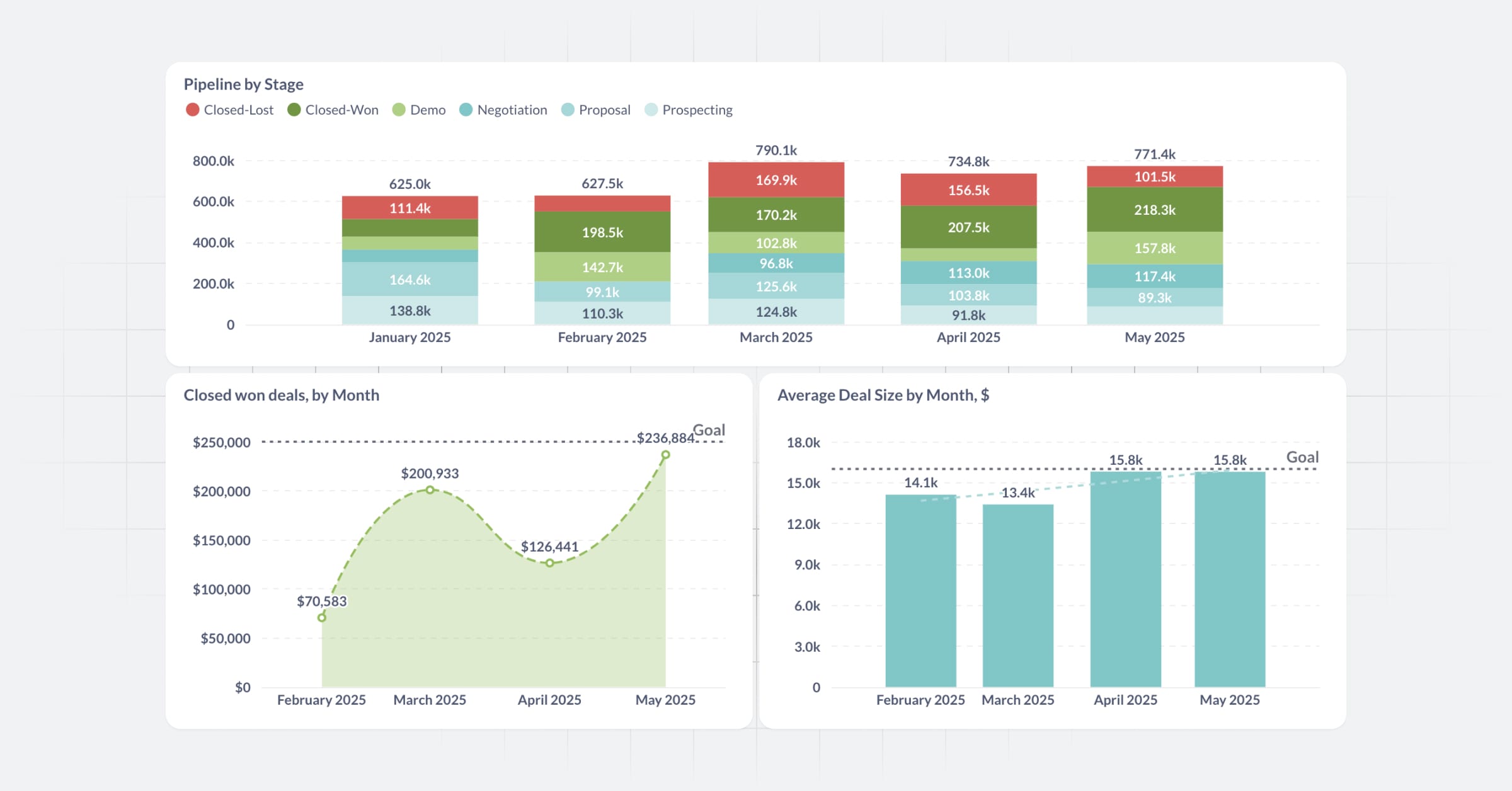‧
24 min read
Metabase alternatives: peeking at other Business Intelligence tools
Jess Thompson
‧ 24 min read

Share this article
A snapshot of the Business Intelligence landscape—who excels where, who it’s for, and a pinch of community insight (plus, a Metabase twist).
This list is not meant to be exhaustive, but an overview of what the different Business Intelligence tools are available, who they’re best suited for, and what they’re best at. Is this colored by our own Metabase-osity? Well, maybe a little. We’re building the BI tool that we want to use, and iterating with the feedback and support of our customers and community. We’ve tried to keep some balance by providing pros and cons from comments on Reddit, including for ourselves.
To give a bit of perspective, we’re providing an overview of the most common Metabase alternatives, including:
Before jumping into the detailed overview of each tool, here is how they stack against each other:
| Feature/Functionality | Metabase | Tableau | Power BI | Looker | Mode | Apache Superset | Quicksight | Domo |
|---|---|---|---|---|---|---|---|---|
| Wide Range of Visualizations | ✔️ | ✔️ | ✔️ | ✔️ | ✔️ | ✔️ | ❌ | ✔️ |
| Custom SQL Query Support | ✔️ | ✔️ | ✔️ | ✔️ | ✔️ | ✔️ | ❌ | ❌ |
| Embedded Analytics | ✔️ | ✔️ | ✔️ | ✔️ | ✔️ | ✔️ | ❌ | ✔️ |
| Interactive Dashboards | ✔️ | ✔️ | ✔️ | ✔️ | ✔️ | ✔️ | ✔️ | ✔️ |
| Collaboration Features | ✔️ | ✔️ | ✔️ | ✔️ | ✔️ | ❌ | ❌ | ✔️ |
| Open Source | ✔️ | ❌ | ❌ | ❌ | ❌ | ✔️ | ❌ | ❌ |
| Integration with AWS | ✔️ | ✔️ | ✔️ | ✔️ | ✔️ | ✔️ | ✔️ | ❌ |
| Integration with GCP | ✔️ | ✔️ | ✔️ | ✔️ | ✔️ | ✔️ | ❌ | ✔️ |
| Integration with Azure | ✔️ | ✔️ | ✔️ | ✔️ | ✔️ | ✔️ | ❌ | ✔️ |
| Self-Hosted Option | ✔️ | ✔️ | ✔️ | ✔️ | ❌ | ✔️ | ❌ | ❌ |
| Cloud-Native | ✔️ | ✔️ | ✔️ | ✔️ | ✔️ | ✔️ | ✔️ | ✔️ |
| Low-Cost Option | ✔️ | ❌ | ✔️ | ❌ | ❌ | ✔️ | ✔️ | ❌ |
| Ease of Setup | ✔️ | ❌ | ❌ | ❌ | ✔️ | ❌ | ✔️ | ✔️ |
| Active Community Support | ✔️ | ✔️ | ✔️ | ✔️ | ✔️ | ✔️ | ❌ | ❌ |
Metabase
- Best suited for: Startups and growing teams choosing their first BI tool that will be able to keep up with them as they scale.
- Open source: ✅
- Cloud or self-hosted deployment: ✅
- Can be embedded: ✅ From basic (static) embedding available on open source through to interactive embedding with Pro and Enterprise
- Query data warehouse directly: Fully supported
Ok, we’re biased, but Metabase was created to make data and business intelligence easy-to-use for everyone—even your less technical teammates. Features like automagic drill-through let people click on charts to tap into what’s most valuable to them. The query builder lets anyone ask a question without needing to know SQL to visualize data and share dashboards (but you can use SQL if you want to).
It’s also super fast to set up. You can connect to your database, and be querying and creating dashboards within 5 minutes (literally).
Metabase is one of the only BI tools that was designed to be able to query your data warehouse directly (that is, without extracts). Most of the following BI tools do support direct querying in some capacity, but in most cases, a direct query mode has been added later on and it’s generally much more limited than with Metabase.
Metabase also has comprehensive embedding options for in-app reporting that ranges from basic dashboards with filters, white-labeled interactive embedding with iframes, through to seamlessly integrated and customized analytics with the developer-friendly SDK.
The open source edition is free, with paid plans for hosting and premium features for more governance features, additional security and isolation, and advanced embedding functionality and implementation.
You can even use Metabase before you have a database set up.
Metabase reviews
What people like: Ease of use for non-technical people
- “I’ve had a lot of success introducing Metabase at my company. Moving from Excel reporting to Metabase dashboards has greatly improved data literacy in all teams and the feature set is amazing considering is a free product. A lot of questions can be answered through Metabase’s interface without having to use SQL, which is great for non-technical users.” - Link
- “Used Metabase in several startups, my 2c: users don’t know what a table/database/view/column is (should they?), so make sure that they can reach what they need in 2 or 3 clicks. The tool needs to be prepared for this. In my case this was a clear win for Metabase, as it’s designed for non-technical users.” - Link
- ‘I’m using it both personally and professionally. It has been excellent for supplying upper management with “information on-tap”’ - Link
- “I love it. Very easy for users to modify or create their own queries and save their own dashboards with modifications.” - Link
The data is clear: people everywhere love Metabase. You can also read what our customers say about us 💙
What people don’t like: Customization limitations and no git version control
- “My biggest gripe with Metabase was also the lack of Git version control. If you want proper version control, the tool really needs to be code-first” - Link
- “I loved Metabase for its elegant simplicity but if you want complex control over visualization it is not for you.” - Link
Tableau

- Best suited for: Enterprise level companies with large, complex datasets and low need for everyone in the company to run their own reports. Also, Salesforce loyalists.
- Open source: ❌
- Cloud or self-hosted deployment: ✅
- Can be embedded: ✅
- Query data warehouse directly: Limited support
Tableau is one of the best-known BI tools in the market, and as such people have a lot of opinions about it—good and bad. Tableau is often a good fit for enterprise-level companies or larger organizations with more extensive data analysis needs, big data teams, deep pockets, and a lower need for everyone in the org to be able to jump in and run their own reports. It’s got all the bells and whistles, and depending on the maturity of your org, your use case, and requirements, it may be more than you need.
People have some strong feelings about the state of Tableau since it was acquired by Salesforce in 2019, with some saying it’s gotten slower, and buggier with fewer updates.
Tableau’s pricing can be prohibitive for small businesses or startups. Licensing costs for Tableau Desktop, Tableau Server, and Tableau Cloud add up quickly, especially for larger teams. Scaling Tableau across an organization often requires significant IT support for setup, management, and maintenance.
Transitioning from Tableau to Metabase? This cheat sheet compares key features, workflows, terminology, and more.
Tableau reviews
What people like: Visualizations and customization
- “Tableau is way easier (than Power BI) to make it look polished and do advanced charts, so it gets the executive stage.” - Link
- “Tableau makes stunning visualizations and is easy to teach the basics.” - Link
- “Tableau is leading in the creation of dashboards (also creativity in visualizations), however, I am not sure how long that will last.” - Link
What people dislike: Pricing and learning curve
- “Tableau is simultaneously bloated and still can’t do intuitive things without some hacky in-group workaround.” - Link
- “I’d say Tableau has one of the stranger learning journeys. It’s balls easy to do basic charts and dashboards people can pick that up in no time. 4 OOTB charts with quick filters and interactivity, new users can get then in a morning. But just as quickly people run into the “well you can do that but it’s a bit of a workaround”. And that learning curve can be extensive and technical.” - Link
- “Tableau was great, but there are features that I thought should’ve been in there 10 years ago that are still not in there.“ - Link
Learn more about how we compare: Metabase vs. Tableau
Power BI

- Best suited for: Enterprise level companies with large, complex datasets and low need for everyone in the company to run their own reports. May also suit those already in the Microsoft ecosystem.
- Open source: ❌
- Cloud or self-hosted deployment: ✅
- Can be embedded: ✅
- Query data warehouse directly: Limited support
Similar to Tableau, a lot of people are familiar with or have used Power BI, and love or hate it. As with Tableau, it’s generally better suited to enterprise-level orgs who aren’t on a tight budget, and are working within the Microsoft realm. Power BI has more of an all-in-one advanced data integration for data transformation and dataflows for ETL processes. Good if you need that kind of thing, but if you want the flexibility to pick your stack you may end up feeling locked in.
One of the benefits of Power BI is its user community, making it easier to find support and solutions to problems. It’s easy to find a broad range of tutorials and documentation.
Power BI Desktop is offered as a free download, and Power BI Pro is also pretty affordable at $9.99 per user per month. Power BI licensing structure starts to get confusing for larger teams and those needing advanced features.
Transitioning from PowerBI to Metabase? This cheat sheet compares key features, workflows, terminology, and more.
PowerBI reviews
What people like: Integration and end-to-end data tooling; integratation with Microsoft ecosystem
- “I’ve been working in Power BI for the last two plus years and they’re constantly been developing new features that make things just easier and easier where they would have been much more challenging years ago.” - Link
- “Power BI allows you to create and share interactive reports. It’s tightly integrated with the Microsoft ecosystem, which can be a huge advantage in terms of deployment etc. A lot can be done with no or low code, which can be an advantage in some circumstances.” - Link
What people don’t like: Performance and learning curve
- “PBI has severe on-prem limitations and some live feed limitations.” - Link
- “Coming from Excel formulae, DAX and M can be very dauting and have the syntax of a programing language. It takes way longer to grasp. I thought PBI would be something like Excel on steroids but it has nothing to do with it. The visuals, the way tables and graphs are built are completely different. On recent months Microsoft is trying to paint PBI more like Excel but that is a long way.” - Link
Learn more about how we compare: Metabase vs PowerBI
Looker

- Best suited for: Very technical teams who need more extensive governance and modeling strictly in code.
- Open source: ❌
- Cloud or self-hosted deployment: ✅
- Can be embedded: ✅
- Query data warehouse directly: Fully supported
Looker has a lot of fans who like it for its visualization options and customizability. One of the main selling points for Looker is LookML—their proprietary modeling language. One Redditer claims that using LookML as a source-controlled semantic layer gets you as close as possible to a legitimate source of truth.
As well-regarded as LookML is, it’s kind of a double-edged sword. It generally takes at least 6 weeks to pick up, and you can’t do anything with your data in Looker without it. So if you need to get your BI tool and running fast, it might not be the best choice.
Looker used to be revered for its excellent customer support, once known as the Department of Customer Love. That changed when they were acquired by Google and their support team was laid off. Since then people complain about long wait-times and ineffectual help.
Lots of people who have worked with Looker in the past now choose Metabase because you get similar outcomes at a fraction of the price. Floryn switched to Metabase from Looker, saving them roughly 67% of their BI costs while offering better visualizations and easier use (their words, not ours).
Handy to note - Looker and Looker Studio are often conflated, but they’re quite different. Looker offers end-to-end data modeling, governance, and creating complex data systems. And is priced accordingly - that is to say, quite high. Looker Studio is a free, but simple dashboarding tool without all the modeling and governance pieces.
Transitioning from Looker to Metabase? This cheat sheet compares key features, workflows, terminology, and more.
Looker reviews
What people like: LookML
- “I worked with Qlik and Power BI in the past. We moved to Looker 1.5 years ago. I absolutely love it. It allows me to work with the data model layer like code vs Power BI which feels more like dealing with a spreadsheet.” - Link
- “When properly setup and architect ed the efficiency and scale is massive. Its lookML layer is amazing. It can save you hundreds of thousands of \($ when deploying at scale by leveraging a far fewer amount of developers than the competition. However, those developers need to be experienced in working in your selected tech stack, if your Looker/Redshift, Snowflake, Bigquery etc. You need the right people to do it. Its going to cost\), but spend it unless you dont care about the consequences X years from now.” - Link
What people don’t like: User-friendly analysis and pricing
- “I work at a startup and our current issue with Looker is that some teams will not be able to directly query in Looker to know the results of a test or new feature without “intervention” from a developer to model the metric.” - Link
- “Looker is terrible for ad hoc and exploratory work.” - Link
- “Looker is reaaaaaally expensive. Especially for self service users who can actually pull fields from explores and create their own dashboards (viewers are cheaper but then you’re basically just dealing with a subpar Tableau instance since they can’t really self serve). If you end up with broad adoption that might ironically drive your company to move away from the tool because of $$$.” - Link
Learn more about how we compare: Metabase vs Looker
Mode

- Best suited for: Analysts and data teams with advanced analysis, visualization, and collaboration needs and prefer to work in SQL, R, and Python.
- Open source: ❌
- Cloud or self-hosted deployment: ❌ cloud only
- Can be embedded: ✅
- Query data warehouse directly: Fully supported
Mode is geared towards data analysts and SQL-savvy people. It provides a coding environment that allows people to write custom SQL queries and perform complex analysis with pretty robust collaboration features. It also supports R and Python for workflows with statistical analysis and machine learning. It’s a great choice for data teams working together on analysis projects. Unlike many other BI tools, Mode doesn’t cater to people looking for a point-and-click interface, which may limit its appeal for people outside of data teams.
Pricing isn’t listed anywhere on their website, though one person on Reddit claims price per user is much higher than many other big name software.
Mode reviews
What people like: SQL and advanced analytics capabilities
- “I use Mode. I think it’s pretty great. It’s become my default SQL workbench since we don’t have a standalone tool for that outside the Snowflake workbench. But it has a lot of great features to it. From that pure adhoc query standpoint I love that I can have multiple scripts within one “report” and then save that within a shared folder or my own personal folder to reference. You can even share the links with people to read and the SQL and run the queries.” - Link
What people don’t like: Jack-of-all-trades and pricing
- “Mode Analytics has an identity crisis. It doesn’t know what it wants to be. Is it a SQL query editor? Is it a Python editor? Is it a data reporting platform? Is it a visualization builder? It’s trying to be many things, and does none of them particularly well. You can’t even change the color of a single series. It really does depend on your use case and budget, but from what I’ve seen, the price tag per user is higher than a lot of the big name softwares out there.” - Link
- “Mode Analytics just raised our contract by over 50% without any additional features. Extremely disappointing that they play this bait and switch game. Might as well go with an actual reputable player like Tableau or PowerBI. Superset, Metabase if you’re into open source. I would broadly not recommend Mode Analytics.” - Link
Superset

- Best suited for: Highly technical teams with extensive data analysis needs.
- Open source: ✅
- Cloud or self-hosted deployment: ✅ (cloud-hosting via Preset)
- Can be embedded: ✅
- Query data warehouse directly: Fully supported
Apache Superset is an open-source business intelligence platform that started out as an in-house project at Airbnb. Superset has a lot of advanced data analysis functionality and a really broad range of complex visualization options. It requires a good amount of technical expertise and resources to deploy and manage.
Its SQL editor is a key strength, empowering analysts and engineers to write, test, and visualize SQL queries directly within the platform. It also boasts a wide array of built-in visualization types, ranging from traditional charts and graphs to more complex, interactive options like geospatial visualizations and custom D3.js charts.
Like Metabase, Superset is well-suited for both internal analytics and embedding analytics into customer-facing applications, giving it versatility across use cases.
Installing and configuring Superset often involves setting up dependencies like a metadata database, web server, and Celery worker for asynchronous tasks, which can be time-consuming and makes it a better fit for teams with solid engineering resources.
Superset reviews
What people like: Visualization and charting features
- “I feel it’s one of the best free viz tool in the market, but it’s free. So its functionalities are limited.” - Link
- “Great visualization types and a better way to arrange graphs.” - Link
What people don’t like: Technical time needed
- “These platforms are great but they have different target audiences than an off the shelf BI tool like Tableau or PowerBI. These systems were made with developers in mind and take a level of technical (coding) expertise to use effectively. And setup and maintenance generally requires a devops or webdev team.” - - Link
Learn more about how we compare: Metabase vs Superset
Domo

- Best suited for: Enterprise-level companies with big budgets who need direct integrations with hundreds of tools.
- Open source: ❌
- Cloud or self-hosted deployment: ✅
- Can be embedded: ✅
- Query data warehouse directly: Limited support
Domo is an all-in-one style data tool that combines data warehousing, transformation, visualization. It wins fans in the executive and C-suite teams thanks to its polished look and feel and high quality visualizations. Depending on the team and use case, some people really value that you centralize all your data jobs, while others feels like it’s a bit [master-of-none](https://www.reddit.com/r/BusinessIntelligence/comments/m8i8jb/comment/grpt7sa/ tool that leads to frustration for those that have to work with it.
Domo lets you integrate with hundreds of different data sources, including but beyond databases, warehouses and lakes - you can plug in directly to a range of tools as diverse as Instagram, to Google Fit, to Workday.
Domo is also only available on Cloud, so if you need or prefer to self-host it’s not the best fit.
Pricing is described as as expensive and mysterious—exactly no one’s favorite adjectives when talking about pricing. Their switch to consumption-based pricing runs on credits, is also controversial in some circles.
Domo reviews
What people like: Integrations and all-in-one data tool functionality
- “I used Domo for 5 years before switching to Power BI. It’s easier to use the visualization tools, and has your ETL and Data Warehouse attached to the visualization tool. And all three are usable without data engineering talent. So it’s good if you don’t already have a warehouse and etl tool. If you do then IMO you’re paying for capabilities you don’t need.” - Link
- “Domo is very pretty. It sounds silly to put this on the chart, but it’s 100% of the reason my COO/CFO were interested.” - Link
- “Good tool for companies with the cash to spend that may not have deeper data infrastructure and staff that can support more powerful tools.” - Link
- “Tons of connectors, can stand-in as a data warehouse, or import from existing DWs” - Link
What people don’t like: usability, pricing
- “It’s pretty rough. The UI is a mess, there are weird limitations everywhere, null handling is different in different data sources, everything is slow and clunky” - Link
- “It’s a full stack BI tool. Which is great if your team is non technical, but if your team wants control of their data and pipelines, it’s not the right tool. Typically you would have an ETL tool, a data warehouse, and a BI tool. Domo tries to do all that in their platform and lacks in each aspect compared to specialize tools” - Link
- “Our contract with domo is going up 2.5x with their new credit pricing model and we can’t afford it now.” - Link
- “I tried getting pricing info from Domo once and the experience told me all I needed to know about them as a company. If your sales pitch for Domo vs Tableau pricing is “just trust me bro” then you can f*** off.” - Link
Learn more about how we compare: Metabase vs Domo
Quicksight

- Best suited for: Larger organizations deeply embedded in the AWS ecosystem
- Open source: ❌
- Cloud or self-hosted deployment: ❌ Fully managed cloud only
- Can be embedded: ✅
- Query data warehouse directly: Limited support
As part of Amazon Web Services, Quicksight is a fully managed service on AWS and naturally it works best alongside other AWS tools. The pay-per-session pricing may be a good fit for large-scale deployments with sporadic or fluctuating usage.
If you’re invested in the AWS ecosystem it works well. Redditors say it’s really made for people who use AWS who want really simple visualizations, not so much enterprise-level BI.
Quicksight offers some advanced analytics functionality, like machine learning-powered anomaly detection and forecasting. Quicksight also has a mobile app.
Unlike more most of the BI tools on this list, QuickSight has a smaller user community and fewer third-party integrations, which can make troubleshooting and extending its capabilities more challenging.
Quicksight reviews
What people like: Simple visualization and working with big datasets
- “The datasets can be really big, up to 1 TB. I have a 500 GB dataset that has about a dozen filters on it in the final dashboard and the performance is pretty good. It’s not always instant, and sometimes it’s slower than other times.” - Link
- “For simple visualizations it’s great. I think design and development is faster compared to Tableau and they have a paginated reporting feature. QS being web based has its advantages, like right now when my work device is broken and I have to use my personal device.” - Link
- “QuickSight has some cool advantages in that it can be managed as code and replicated across regions fairly easily. It’s not perfect, but I’m generally a fan.” - Link
What people don’t like: Pricing, limited customization, performance
- “The filters drive me absolutely insane. My view is that a simple many-to-one table where you have a well-defined dataset with simple aggregations would be fine in QuickSight. If you need to make a simple dashboard it works great. AWS makes it easy to connect to their native services. Anything beyond this, however, and everything becomes “yeah, you can get this done, but there is a 20 step workaround.”’ - Link
- “The visualizations aren’t very powerful and can’t generally be customized. Some random ones support one or two special things, but for the most part you’re incredibly limited on visuals.” - Link
Choose the Business Intelligence tool that better suits your need
There are no right or wrong answers here. It will generally depend on your use case, how much you want people to be able to learn from data and run reports on their own without depending on your data team; your preferred data stack, how fast you need to get up and running, your budget, and more. If you’re still on the fence, we hope this list of common alternatives to Metabase provides some insight into what’s available and how people generally feel about them.
Again, there’s no “right” answer, - but Metabase will let everyone on your team work with data, integrates with your preferred data tools, get ups and running in 5 minutes flat, and suits all budgets (plus you can try it for free). We’ve put a lot of thought and effort into making a BI tool that aims to be a joy for everyone on your team to use, regardless of their technical proficiency 💙



